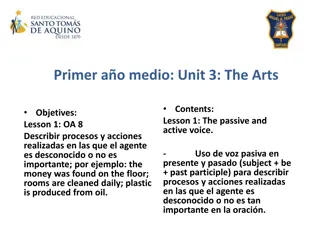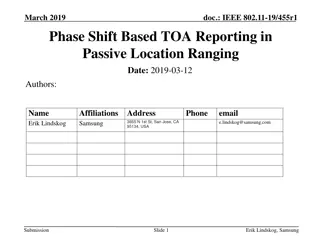Understanding Active vs. Passive Immunity for Better Health
Immunity is the body's defense mechanism against diseases. Active immunity occurs through exposure to antigens, either naturally during infection or artificially through vaccines. It leads to the production of memory cells for long-lasting protection. On the other hand, passive immunity involves receiving antibodies, either naturally from mother to child or artificially through injections, providing immediate but temporary protection. Promoting health and wellness in the workplace includes measures like promoting preventive care, encouraging exercise, and supporting vaccination programs.
Download Presentation

Please find below an Image/Link to download the presentation.
The content on the website is provided AS IS for your information and personal use only. It may not be sold, licensed, or shared on other websites without obtaining consent from the author. Download presentation by click this link. If you encounter any issues during the download, it is possible that the publisher has removed the file from their server.
E N D
Presentation Transcript
ACTIVE VS. PASSIVE ACTIVE VS. PASSIVE IMMUNITY IMMUNITY
Immunity: The state of being immune from or insusceptible to a particular disease or the like. The condition that permits either natural or acquired resistance to disease. The ability of the cell to react immunologically in the presence of antigen.
Natural Active Occurs during infection. It is active because lymphocytes are activated by antigens on pathogen's surface.
Artificial Active Artificial Active Injecting or taking antigens by mouth. Takes time for T and B cells to be activated but gives long lasting immunity.
Active Immunity Memory cells are only produced in active immunity. Protection for active immunity is permanent whereas in passive immunity it is only temporary. Antigens are only encountered in active immunity. Active immunity takes several weeks to become active but passive is immediate
Natural Passive Natural Passive Mother to child through placenta or milk.
Artificial Passive: Artificial Passive: Used during potentially fatal diseases. Provides an instant response but only temporary as antibodies are not the body's own so memory cells are not created. E.g. tetanus - injection of antitoxins given.
PROMOTING HEALTH PROMOTING HEALTH AND WELLNESS IN THE AND WELLNESS IN THE WORKPLACE WORKPLACE
1. Promote Preventive Care Bring vaccination to the workplace for flu season. Encourage and fund vaccinations.
2. Encourage Exercise Offer covered, secure bike parking for commuters. Provide showering facilities and locker rooms for employees who want to workout at lunch. Promote a lunch hour walking club and offer incentives for employees who participate.
3. Emphasize Education Break-time seminars to learn about healthy habits. Recruit speakers to lead sessions on cooking healthy meals, staying healthy while traveling, or quick stress management skills.
4. Bring the Doctor In Host on-site health clinics. Employees do not have to worry about taking off time from work.
5. Invest in Incentives Offer employee incentive programs that yield financial or other awards. Incentives only for those who engage in healthy behaviors. Work with your insurance company to adjust premiums based on biometric markers.
6. Hone Hunger Options Offer employees healthy meal and snack options. Replace sodas with juice, milk, or water. Stock snack machines with nuts and dried fruits. Have fresh fruit baskets.
7. Be Mindful of Mental Health Offer employee assistance programs: Financial troubles Excess stress Depression symptoms Encourage steps for stress reduction.
8. Recommend Behavioral Resources Make use of coaching and disease management programs. Consider offering: Tobacco cessation Weight loss programs Stress management programs
Resources: Inc.com http://www.inc.com/guides/2011/01/8-ways- to-promote-wellness-in-the-workplace.html

















































